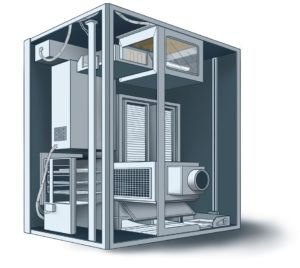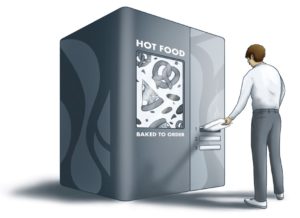CASE STUDY: FOOD AUTOMATION VENDING MACHINE
Oven-baked, Touchless, Foods On-demand
![]()
THE PRODUCT
In a time where food preparation with limited touchpoints is becoming more important, this freestanding food automation vending machine is designed to serve fresh, hot, oven-baked foods on-demand in minutes. The vending machine utilizes smart, cutting-edge technology to create a quick and easy cashless experience for consumers with no human interaction necessary.
A proprietary refrigeration system preserves freshness while attaining the highest safety and sanitation standard. With a clean room environment inside the vending machine and a mobile app for touchless ordering, payment and rewards, the vending machine offers a safe and sanitary experience for users at any time of day.
A 32-inch user interface informs customers which foods are on the menu. A mobile app is also provided to allow a fully connected experience for vending machine operators with remote stock management, so inventory never gets low or expires.
With a footprint of only three by five feet, the vending machine can fit in a variety of environments such as breweries, office workplaces, hotels, school campuses, airports, and hospitals.
The vending machine has 10 different mechanical sub-systems to move trays holding the food items from the refrigeration unit, through the oven unit and to the three output chutes for delivery to the customer. The process and mechanisms are controlled by 2 microprocessors for real-time control and an embedded industrial PC to control and coordinate the overall machine operation, run the user interface, and perform reporting and billing operations.
THE CHALLENGE
When the client first came to Simplexity, they were already months past the intended delivery date, but the design of the vending machine had never successfully delivered a full load of trays without a critical system failure. The program was both significantly behind in schedule and significantly over budget. The client had a near term goal of demonstrating a working unit at a trade show, and a goal of getting into production within nine months.
The client sought out Simplexity due to our expertise in the design of mechatronic systems. The client presented the challenge of getting the unit into production with minimal redesign, with a specific target of not changing the refrigeration unit or the main control circuit board to avoid impacting existing design certifications. The goal was to provide an initial working unit within the first quarter of the program, and to get a qualified design into production by the end of the third quarter of the program.
THE SOLUTION
Simplexity’s first task was to assess the current state of the full system design. Simplexity performed various analyses:
- Full review of defect logs to understand where the system failures were occurring.
- Full design review of all core systems:
- Electronics, motors, motor drivers, sensors, microcontrollers.
- All tray handling mechanisms, tray handoff interfaces and output chute door control, including an analysis of the critical tolerance loops affecting tray handoff and output chute door control.
- Firmware source for the embedded microcontrollers and software source for the higher-level machine control that runs on the PC.
- Overall design architecture and tray handling concepts.
- Performed a root cause analysis on each critical defect and mapped the observed defects to observed areas of design deficiency. This allowed the team to prioritize the required changes to maximize the positive impact of the design effort.
- Full review of the system qualification test plan.
At that point, Simplexity generated concept designs for the key required redesign areas, estimated the work required to implement the changes and reviewed these with the client.
“I just wanted to pass along my sincere thanks to the whole team at Simplexity for all the hard work that everyone is doing to support the project."
-Client Confidential
Simplexity’s engineering team implemented a host of design improvements for the food automation vending machine:
- A complete rewrite of the real-time firmware running on the microcontrollers, including a fully documented communications protocol with the PC.
- A complete rewrite of the motion sequencing and control portion of the PC software. It should be noted that the software was partitioned so that Simplexity owned the machine control software while the existing design partner retained ownership of the user interface (UI), stock tracking telemetry, and financial transaction software.
- A remapping of the motors and sensor to the microcontrollers to so that each tray motion subsystem resided wholly in one microcontroller.
- Selection and validation of new sensors for tray mechanism management.
- A full redesign of the refrigerator tray cartridge used to store and dispense trays, including redesign of a critical tray handoff mechanism on the refrigerator output.
- Redesign of the tray transport on the elevators for oven input and output.
- Redesign of the tray transport from output elevator to delivery chutes.
- Redesign of the chute door opening and locking mechanism including replacement of a low torque solenoid with a stepper motor.
Each mechanical subsystem was prototyped, tested, iterated then integrated into the vending machine system. Within six weeks from design start, Simplexity demonstrated the system delivering the first full load of trays with optimizations to support up to three trays in-process simultaneously.
After the initial demonstration, Simplexity began a rigorous test protocol to shake out the system, surfacing secondary design defects and eventually demonstrating the client-required robustness of tray delivery. Simplexity was able to successfully execute the test protocol within the allotted timeframe allowing the design to be delivered to manufacturing on schedule.
THE RESULTS
A fully functioning food automation vending machine that achieved the acceptance criteria of passing 720 trays without a failure.
- Number of Parts Created: 104
- Firmware Lines of Code (LOC) Delivered: 10.5k
- Additional 2.7k LOC of test code
- Software LOC Delivered: 11.3k
- Additional 13.3k of test and development support code
- Number of Trays Processed: 15K
“It was good to see your operation and the people that build the reputation of the company. I was impressed with all I saw and hope to continue our relationship with other programs in the future.”
-Client Confidential
Do you have a food automation or mechatronic product that needs expert design services to simplify your design, help you reduce cost, and improve reliability?
Let us know how we can help!



